- Sale
- 360 Degree Photography
- Battery and Battery Grip
- Backgrounds Even Color
- Backgrounds with Print
- Background Systems
- Camera Accessories
- Camouflage
- Continuous and Videolight
- Filters, Converters and Rings
- Photo frames
- Clamps and Adapters
- Cases and Bags
- Bulbs
- LED Lighting
- Magnifying Glasses
- Macro Photography
- Microphones
- Microscopes
- Night Vision Devices
- Shooting Tables and Tents
- Outdoor and Survival
- ID Photo Systems
- Flash Umbrellas
- Printers
- Reflectors
- Reflectors and Snoots
- Riflescopes
- Rigs Sliders and Stabilizers
- Camouflage Hides
- Smartphone Accessories
- Soft Boxes and Beauty Dishes
- Speedlite Camera flashes
- Spotting scopes
- Tripods and Ballheads
- Strobist
- Studio Accessories
- Studio Flashes and Kits
- Tecco Print Media
- Telescopes
- Trigger Sets
- Binoculars
- Thermal Imaging
Purchasing Binoculars
Which Magnification Should I Purchase?
Most binoculars have a magnification between 5x and 20x. A higher magnification is not always better. It is important to think carefully about where you’re wishing to use your binoculars and what for. If you want to use your binoculars while you’re out walking, a magnification of 8x or 10x is advised. However, if you want to view objects from a fixed location, a higher magnification is advised. With binoculars that have a higher magnification, it is wise to use a tripod in order to prevent vibration in your image.
Below you will find a table outlining the appropriate use for the different binoculars available.
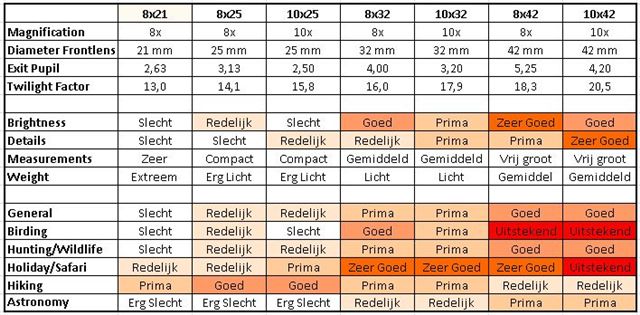
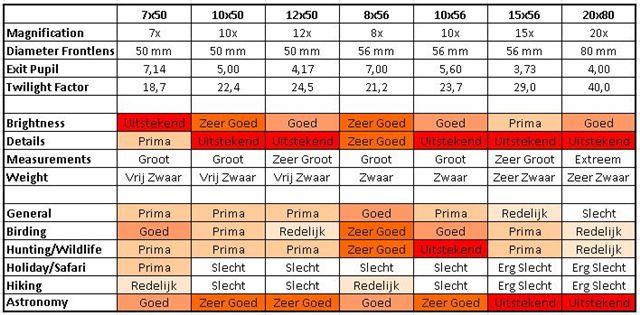
How Much Should I Spend on a pair of Binoculars?
In regards to binoculars, it really is true that you get what you pay for. As a beginner, it is possible to purchase a good pair of binoculars for around € 100. A more advanced user will probably spend between € 250 and € 750 for a pair of binoculars and professional optics can easily exceed € 1000. The table below aims to explain this in simple terms.
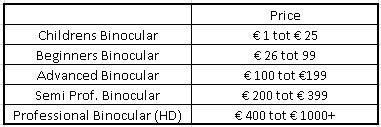
How do I use the Diopter Adjustment?
In order to set the diopter, it must first be set to zero. Cover the objective lens on the same side as the diopter adjustment wheel. Look through the other lens and turn the adjustment until you have a clear picture. Then cover the other objective lens and look through the binoculars. If the image is not sharp, turn the adjustment to sharpen the image.
If I wear Glasses, do i need Special Binoculars?
This depends on the reason you wear glasses. If you wear glasses because you are longsighted then it may not be necessary as adjustments on regular binoculars can be made with the focus wheel. However, if you wear glasses for a different reason, it is advised that you look for a pair of binoculars with an eye relief between 10mm and 20mm. Alternatively, you could look for a pair of binoculars that contain ‘twist up’ eyepieces. These are rubber caps that you can turn out to put against your eyes.
What is Eye Relief?
Eye relief, also known as the exit pupil distance, is not to be confused with the exit pupil diameter as mentioned above. This number is the ideal distance between the eyepiece lens and your eye. The exit pupil distance is related to the magnification, when the magnification is raised, the exit pupil distance becomes smaller. People with glasses need to pay special attention to this matter when buying a binocular because the glasses influence the distance between the eyepiece lens and the eyes.
Should I use a Tripod?
In most cases you will not need to use a tripod. However, if you are planning to view a lot from one location while using binoculars with a high magnification, you could use a tripod. This is ideal for viewing with less light. Binoculars with a high magnification are generally heavier and need a tripod to prevent vibration in your image. If you want to use a tripod, but need to stay mobile, you should look for a monopod (tripod with one leg).
How do I Mount my Binoculars onto a Tripod?
To mount your binoculars on a tripod, you will usually need an ‘L’ shaped adapter. The Uni-Daptor by Vortex is easy to use and can be easily removed when you want to use your binoculars without the tripod. A more standard solution is the universal Konus tripod adapter.
What is Field-of-View (FOV)?
FOV stands for Field-of-View and is the same as vision. This refers to the width of the image as seen through the binocular. Usually, this will be indicated as the width at a certain distance or in degrees. The wider the field-of-view, the easier it is to find your subject. For example, a field-of-view of 133 to 1000 meters means that the entire image through the binocular at 1000 meters is 133 meters. ?If this is specified in degrees then this can be done in two ways, with the field-of-view in degrees or the "subjective field-of-view" in degrees. When provided with the field-of-view in degrees, you multiply the number by 17.5 in order to obtain the field-of-view at 1000 meters. When the given number in degrees is higher than 15, the subjective field-of-view is being referred to. In this case you divide the number by the used magnification to obtain the field-of-view and then you multiply this number by 17.5 to obtain the field-of-view at 1000 meters.
How do i Clean my Binoculars?
Start by blowing away all dust and filth. Next, use a lint-free cloth, such as a camera lens cloth and lens cleaner or alcohol to clean. On the outside of the lenses you can use warm water and a mild detergent to clean the metal, rubber or plastic. The coatings are very sensitive to scratches here so you should be extra careful when cleaning your binocular. Also, it is advised that you read the user manual before you start.
How do I take my Binoculars Apart to Clean them?
You should never do that! In most cases it is not necessary to take the binoculars apart. Many binoculars are filled with nitrogen so the optics will not get foggy. If you believe that the inside needs to be cleaned, please contact the manufacturer or dealer.
Binoculars are known as optical instruments used to view distant objects. Hans Lippershey from Middelburg invented the first Dutch binoculars in 1608. Over the years, Hans’ design has evolved to the binoculars we know and use today. Nowadays, binoculars consist of a pair of identical telescopes mounted next to each other and are aligned to point in the same direction. Both halves consist of an objective and an eyepiece lens. Further, binoculars also contain prismas, which ensure that the image you see is turned the correct way up. Without the prism, the image you would see through the binoculars, would be upside down. In order to magnify an object in the distance through a pair of binoculars, the lenses must 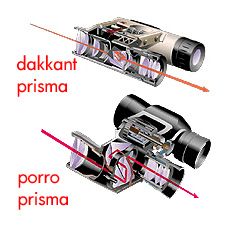 be placed a certain distance from each other. Due to the prism located within the binoculars, the distance between the lenses does not need to be great. This is why the binoculars today, are much more compact.
be placed a certain distance from each other. Due to the prism located within the binoculars, the distance between the lenses does not need to be great. This is why the binoculars today, are much more compact.
What is the Difference Between Porro and Roof Prism Binoculars?
Porro binoculars pass the light through a corner and look like traditional binoculars. Because of this angle, porro binoculars are larger than roof prism binoculars. Porro prism binoculars do however provide more light. When using a roof prism binoculars the light filters through the binoculars straight to the eyes. Generally, roof prism binoculars cost much more than porro binoculars.
What is Coating?
A coating is a layer on the glass surface that improves the performance of the binocular. The main purpose of this layer is to filter more light through the optics to the human eye. Without a coating, less than half of the light in the binoculars reaches the eye. Because of this, a good coating used on binoculars with smaller objective lenses can filter the same amount of light as more expensive binoculars with larger objective lenses. In addition, coating provide less glare and more contrast.
Please note, not all coatings are the same. In order for binoculars to bear the term "coated", a single layer of magnesium fluoride must be applied to a single lens. Further, this coating must be applied to all lenses of the binoculars to bear the term “fully coated”. It is also possible for a lens to be multi-coated or fully multi-coated. "Multi-coated" means that is at least one lens has multiple layers of coating and "fully multi-coated" means that all the lenses may have up to 25 layers of coating. The top of the range binoculars will often be fully multi-coated with numerous layers of coating.
What do the Numbers Mean? (For Example, 10x42)
The numbers in the example mentioned above represent the magnification and lens size. The first digit represents the magnification of the binoculars. This indicates how much closer the object looks through the binoculars compared to the naked eye. The second number indicates the diameter of the objective lenses in millimeters and thus, the amount of light that comes through the binoculars. Larger objective lenses produce sharper and brighter images. Further, a ‘-‘ between the first and second number and a third number behind the ‘x’, for example 2-10x42, represents a zoom binocular. These binoculars have a variable magnification from the first to the second digit.
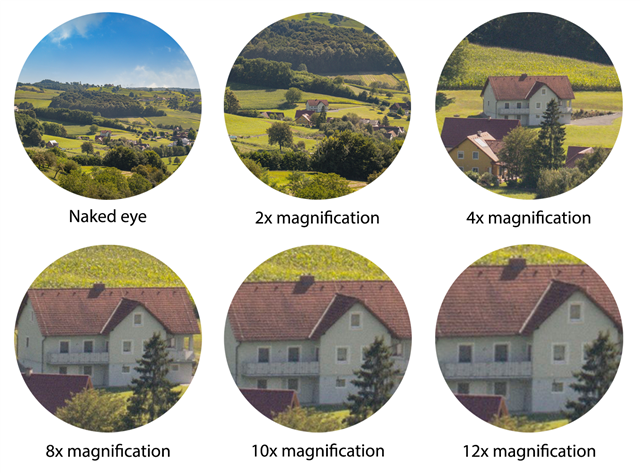
What does Exit Pupil Mean?
The exit pupil is referred to the diameter of the light that comes through the eyepiece. Generally, a large exit pupil is desirable when viewing in lowlight conditions, such as when you go stargazing. A smaller exit pupil is desirable when there is plenty of light available. If the exit pupil number is not specified, you can calculate it by dividing the objective size by the magnification. For example, when using 10x50 binoculars, you divide the 50 by 10 to reach an exit pupil of 5mm.
Luminosity
The luminosity of a pair of binoculars is determined by the amount of light that can be filtered through the binoculars. This can be calculated by dividing the aperture by the magnification and then multiplying it by 2. For example, for a 10x50 binocular, the luminosity would be 25 (50/10 = 52 = 25). This number can not be 100% relied upon due to the quality of the glass used for the lenses and the coating applied thereto.
These are different factors that, effect the collection and quantity of light filtered through the lenses and thus impact the luminosity. A pair of 10x50 binoculars with HD glass and full multi-coated objectives will have a much higher luminosity than a pair of 10x50 binoculars with standard glass and single coated objectives.
Twilight Factor
The twilight factor measures the effectiveness of viewing suing low light conditions. The minimum twilight factor that a pair of binoculars should have is 15. Any lower than 15 indicates that the binoculars are actually just to be used with enough daylight. To calculate the twilight factor, you must find the square root of the magnification and aperture. Using the same 10x50 example as above, 10x50= 500 and √500= 22.36. With the twilight factor equaling 22.36 and therefore being higher than 15 in this example, it indicates to us that these binoculars are suitable for use during low light conditions.
What are BK7 and BAK4?
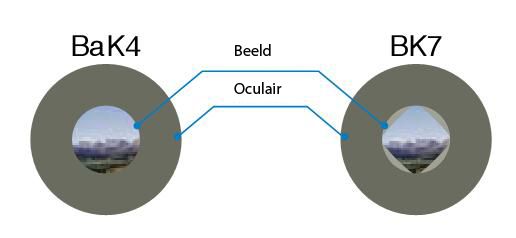
This is the type of glass that is used for the prisms. BK7 is borosilicate or borosilicate glass and BAK4 is barium crown glass. Generally BAK4 glass is more expensive and better as it displays a sharper and clearer picture than BK7. BAK4 gives a perfectly round exit pupil and BK7 often distorts the edges.
Purchasing a pair of Binoculars
Now that you are aware of the most important features and you have made the decision to purchase a pair of binoculars, it is essential that you purchase the binoculars that best suit your intended use. Should you need further advice on which binoculars will best suit you, please see our purchasing advice page.